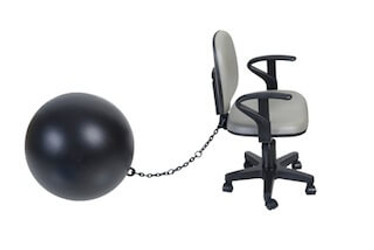Part 3 Conclusion: What’s the Hubbub About Ball Chairs? Are They Really Ergonomic?
Posted by Ian Chong, CPE on 15th Aug 2017
[Editor's note: This is part 3 -- the conclusion -- to a series that began with What’s the Hubbub About Ball Chairs? Are They Really Ergonomic?]
Some folks seem to think that perception is not everything, it is the ONLY thing. After analyzing the various opinions of Ball Chair usage by our informal task group, it seems that perception is close to the ruling and deciding factor whether the ball chair is functional for them. Not necessarily surprising, considering that perception appears to be the ruling king for other things in the ergonomics world.
Naturally, there are some exceptions. Safety for example, is a key consideration, even surpassing perception. The potential for air collapse making the ball crash like the Hindenburg perhaps takes at least equal priority… especially in the case of the person who uses the ball as a chair because of their back condition. Secondly, the total inherent instability of a ball gives the safety professionals on our task force the weebie jeebies. “Man, that’s Safety 101,” exclaimed one of our colleagues – “ensure the safety of all workers through engineering, process or methods.” The ergonomists of our task force immediately stated that the workstation should take care of the health of the worker (and prevent injuries) without the worker having to take a conscientious effort at maintaining their own safety. The workstation, including the chair (or ball) should not introduce a hazardous condition for the worker to deal with, much like forced attention while walking a tightrope.
Indeed, safety should be placed ahead of even perception. “But Dude, didn’t you just say that perception trumps everything and if someone thinks it’s great, in spite of all its shortcomings, doesn’t that mean that it is indeed great according to your perception theorem introduced through this whole series?”
Well, yes, it does - however a modicum of safety should be emphatically introduced here. There is no speed limit on Europe’s Autobahn, however you better have a fancy sports car that can run, brake, and handle those high speeds for your own safety. And like that fancy red sports car, your ball chair should be definitively controllable - stable and ensured of all safety features to keep your behind off the floor. Remember my case with the lady who sat in a chair that featured a loose backrest - as she sat down first thing in the morning and leaned backwards, the loose chair back let her fall backwards so she hit her head on a radiator fracturing cervical vertebrae. The same thing could happen with a ball chair popping, quickly deflating or simply by an inattentive user rolling off an inherently unstable seating device.
Our market researcher shed some light on the conundrum -- acceptance of the ball chair as a change, attractive as non-traditional out of the box thinking. Speaking from personal and professional experience, the designers are the worst -- often resorting to calling such devices ergonomic (look for future columns dealing with this subject). We’ve all seen examples of this and are even sometimes swayed by such antics, which work for ball chairs too. There are those who TOTALLY buy into this thinking, lock, stock and barrel, and espouse the benefits of such “ergonomic” items using all the tools at their disposal to convince someone that their logic is right. One of these tools of course is to button hole an easy target, which just happens to be the friendly neighborhood ergonomist (real or voodoo) making their rounds performing workstation modifications.
Final Conclusion
So after all of our research, we have to come to this conclusion: Safety comes first - utmost and primary, irrespective of perception. If you think that product is great for you, then Godspeed to your perception and use it, but like driving that fancy high performance red sports car make sure you know how to control it - otherwise you’ve got no business driving (or sitting on) it lest changes occur in your health from a pulled muscle from an unanticipated posture correction to a fractured skull/fractured vertebrae when you go off balance and you hit your head on the polished marble floor. The result is too heavy a price to pay for being hip or cool or the first on the block. They may be good for a specific application, or they may address a short term condition, but not for the everyday for everyone.
The exercise physiologist who responded to an earlier article may have hit the nail right on the head: “Use an exercise ball for what it was intended, an exercise ball, not a task chair” - kudos for your insight and logical thinking.
If you have a condition in which the ball chair seems the only solution, you might seek out a REAL ergonomist (not a PT, not an OT, nor a chiropractor - but a real ergonomist) to track down what the real symptomology trigger is and then figure out a real chair that would be applicable. I suspect if you do this and have become a die hard, flag waving ball chair proponent, the final answer will be one of perhaps using this ball only occasionally with primary use of a real chair with real features to address your occupational injury.
There may be one-in-a-million folks who can aptly use a ball chair safely full time. I haven’t found them yet. But if you are one of those, be careful and keep constant vigilance for that one split second emergency situation and be prepared for when it occurs. Oh, and by the way, you will probably experience a bit of a drop in productivity while you multitask to keep that portion of your mind focused on not splitting your head open.
Ian Chong, a Certified Professional Ergonomist with Seattle based multi-disciplinary Extreme Ergonomics Inc., designs and prototypes unique tools, equipment and workstations addressing occupational injuries in all occupational environments, industrial and office on a national level. Ian holds advanced degrees in Ergonomics & Occupational Biomechanics, Industrial Design; and Architectural Engineering, and is also profiled in the Oregon Museum of Science and Industry.
Originally published on ergoweb.com March 9, 2011.

